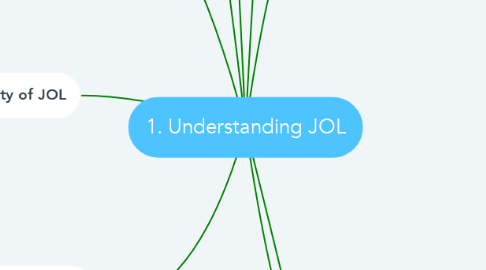
1. JOL in MT
1.1. Curiosity / Interest (T1, T3, T4, T5, T6)
1.2. Active engagement / Involvement (T1, T4)
1.3. Students' ownership of work (T1)
1.4. Love / passion for language and culture (T3, T5, T6)
1.4.1. ML = Source of identity??
2. 3. Strategies in teaching MT
2.1. How to drive students to realise the importance of learning MT?
2.1.1. Through inculcating the moral and cultural aspect (T2, T4))
2.1.2. Relevance to students' lives (T3)
2.1.3. Use of use of music and the arts, stories that inspire and carry valuable lessons (T3)
2.1.4. Explicitly tell the pupils that learning MT will build one’s character (T3)
2.1.5. Teacher speaking only in MT (T4)
2.1.6. By sharing the stories of their heritage and of their ancestors (T6)
2.2. How to increase excitement levels amongst students in learning MT?
2.2.1. Games and cultural aspects (T1, T2, T4, T5, T6)
2.2.2. Relevance to daily lives (T3)
2.2.3. Level of rapport with teachers (T4)
2.2.4. Use of ICT (T4)
2.2.5. Groupwork (T4)
2.2.6. Role-playing and story-telling(T5)
2.3. Existing strategies in schools that students enjoy
2.3.1. MT Fortnight (T1, T4, T5, T6)
2.3.2. Cultural activities (T2)
2.3.3. MT Reading Programme (T3)
2.3.4. Inter-class competitions using ICT(T4)
2.3.5. Termly quizzes (T4)
2.3.6. Collaboration with peers (T4)
2.4. Ways to spark students' engagement beyond standard classroom practices
2.4.1. Outside based classroom activities. Learning journeys, interesting workshops and language camps (T1, T5)
2.4.1.1. Students will see that learning MT is not just restricted to books and for assessments. More relatable to their lives
2.4.2. Informal conversation in MT (T2)
2.4.2.1. Show the relevence/connection of the language with their daily lives.
2.4.3. Tap on relevant trends (T3)
2.4.3.1. Increases students' interest
2.4.4. Parents involvement (T4)
2.4.4.1. Students will be in their comfort zone and are more willing to learn and converse in MT instead of it being a language they are forced to speak in the classrooms.
2.4.5. ICT (T6)
2.4.5.1. Students enjoy using technology to learn because it is different from the tradional way of learning through books and paper.
2.4.6. Collaboration with peers (T6)
2.4.6.1. When students collaborate with their peers, they get to mix around and learn from one another.
3. Importance of JOL in MT
3.1. IF STUDENTS EXPERIENCE JOL
3.1.1. Learning MT more tedious than EL (T2)
3.1.2. sustain students' interests (T1, T6)
3.1.3. Improves classroom management (T3)
3.1.4. Improves quality of learning (T5)
3.1.5. Boosts students' confidence in speaking MT (T4)
3.1.6. Increases motivation levels in learning MT (T3,T4)
3.1.7. Helps students to remember the lesson (T6)
3.2. IF STUDENTS DO NOT EXPERIENCE JOL
3.2.1. ABLE TO LEARN MT
3.2.1.1. Motivation level eventually decreases (T1)
3.2.1.2. Forced by parents, teacher, syllabus to learn MT (T3, T6)
3.2.1.3. Through road memoriation (T5)
3.2.2. NOT ABLE TO LEARN MT
3.2.2.1. Adds to the difficulty of learning MT (T2)
3.2.2.2. Students will switch off (T4)
3.2.2.3. Not able to retain info (T4)
3.2.2.4. Learning not meaningful (T5)
4. Impact of PSLE and EOYS on JOL
4.1. POSITIVE IMPACT ON JOL
4.1.1. Able to show how JOL has significantly impacted students' learning process (T1)
4.2. NEGATIVE IMPACT ON JOL
4.2.1. Too much stress / pressure on students and teachers (T5, T6)
4.3. Impact of NO PSLE and EOYs?
4.3.1. POSITIVE IMPACT ON JOL
4.3.1.1. Able to learn at students' own pace (T4)
4.3.1.2. More time for fun activities outside syllabus and curriculum based learning (T4)
4.3.1.3. No longer stress (T5)
4.3.2. NEGATIVE / NO IMPACT ON JOL
4.3.2.1. Depends on everyday learning process (T1)
4.3.2.2. . PSLE and EOYs are goals that gives the pupils a sense of motivation towards achieving something (T3)
4.3.2.3. Depends on teacher's way of teaching (T6)
5. Feasibility of JOL
5.1. Feasible
5.1.1. Reduced assessments (T1,
5.1.2. Creates intrinsic motivation (T2,
5.1.3. Oppurtunities created by teachers (T3)
5.1.4. Help from the use of ICT (T4)
5.2. Not feasible
5.2.1. Current materials used in the teaching of MT (e.g. textbooks, storybooks) are too dull and not relevant in students’ lives (T6)
6. Tensions faced by teachers between covering syllabus and JOL
6.1. Time does not permit for teachers to carry out both of these duties well. (T1)
6.2. Book checks (T3)
6.3. Expecations from parents (T3)
7. Sources
7.1. Teaching Practice (T2)
7.2. School leaders (T1, T3, T6, T5)
7.3. NIE (T4)
7.4. MOE (T3)
8. Conceptual understanding
8.1. Student focused
8.1.1. Emotional Perspective
8.1.1.1. Passionate to learn (T5)
8.1.1.2. Look forward (T5, T6)
8.1.1.3. Enjoy lessons (T2, T4, T5, T6)
8.1.1.4. Sense of accomplishment (T1)
8.1.2. Cognitive
8.1.2.1. Relevance/ Meaning (T6, T5)
8.1.2.2. Not assessment (T1)
8.1.2.3. Active engagement (T1, T2)
8.1.2.4. Understand lesson (T3)
8.2. Teacher focused
8.2.1. Emotional Perspective
8.2.1.1. Yes
8.2.1.1.1. Passion (T5)
8.2.1.2. No (T3)
8.2.1.2.1. Rebellious students
8.2.1.2.2. Unreasonable parents
8.2.1.2.3. Class size
8.2.1.2.4. Admin work
8.2.1.2.5. Accountability
8.2.2. Cognitive
8.2.2.1. Purpose and Meaning (T6)
8.2.2.2. Driven by student engagement / learning (T1)
9. 2. Understanding MT teaching in schools
9.1. Student responses
9.1.1. POSITIVE
9.1.1.1. Interest (T1)
9.1.1.2. Eager to learn (T4)
9.1.1.3. Break from speaking Eng (T5)
9.1.2. NEGATIVE
9.1.2.1. Less interest (T1)
9.1.2.2. Speaking EL at home and other subjects (T2, T5, T6)
9.1.2.2.1. MT less crucial (T2)
9.1.2.2.2. Academic needs i.e focus more on other subjects (T6)
9.1.2.3. Unmotivated (T4)
9.2. Importance of MT
9.2.1. POSITIVE
9.2.1.1. PSLE T4)
9.2.1.2. Communicating with older generation (T4, T5)
9.2.2. NEGATIVE
9.2.2.1. Parents' language use at home (T1, T5)
9.2.2.2. No relevance
9.2.2.2.1. to parents (T3)
9.2.2.2.2. in their lives (T2)
9.2.2.2.3. social media / interest in EL (T6)
9.2.2.3. prefer EL (T6)
9.2.2.4. lack of daily use (T3)
9.2.2.5. culture
9.2.2.5.1. old and relevant (T3)
